Antique Desire
AUCTION FINDS OF THE WEEK- SEPTEMBER 9TH: ELEGANT DINING PART IV
by Kelly Keating on 09/07/13
Welcome back to Auction Finds of the Week! This week will be the last in the series of posts on all the objects needed for an elegant dining room. Part I focused on the dining room table, chairs and plates which are the foundation objects of this room. Part II considered how to create a tablescape or centerpiece with items to adorn your table and provide a central focus to the room. And part III found chandeliers which are the other main component that centers the room and sets its tone. This week will consider the other needed pieces for the table itself to complete its decoration and its function: flatware and stemware, the jewelry of the table.
The choice of flatware can set the mood for the table and how that flatware interacts with one's plates. Choose something that is complementary to the china used and to the style of the room. If the dining room has an eclectic look, why not collect different pieces of antique and vintage flatware in silver and silverplate. Mixed flatware can provide a fun and inexpensive way (when choosing silverplate) to create a set to serve 4, 6, 8 people. This mix and match approach could also be done with glassware.
And don't be afraid of using silver flatware. The care is fairly simple. Polish it once and then use it. When done wash in a mild soap and store in a silver keeper role or box which will prevent tarnishing. When you are ready to use your silver again, it will be bright and shiny and ready to go.
The first find this week is a French silver flatware service of 54 peices in a shell pattern. It is being auctioned at Doyle New York lot 64 on September 24, 2013 with a pre-sale estimate of $500-700. A shell pattern is always elegant and simple and could work in a variety of settings. It would work well on the 2 traditional tables in part I- the Georgian style dining table and the Louis Phillipe style oval table. But it could also work with the more modern choices found in part I, the Paul Frankl table and the After Leleu table.
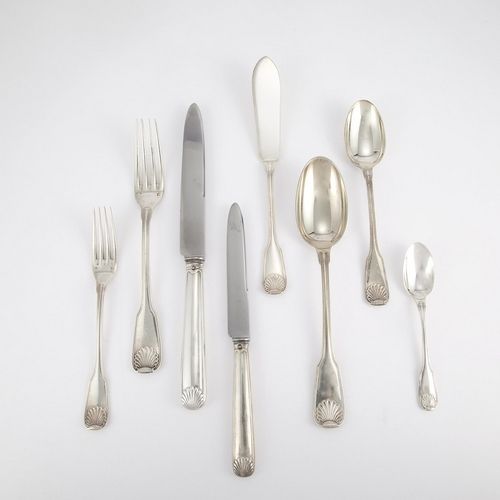
The second flatware discovery this week is much more intricate and grand and would really only be appropriate for more traditional settings, but I just love it. Lot 419 is a service of 134 pieces of sterling silver flatware by Gorham in the elaborate multi-motif Coligni pattern which was introduced in 1889. The lot is being offered by Brunk Auctions in Ashville, NC on September 21, 2013 with a pre-sale estimate of $4,500-6,500. The pattern is an intricate intertwining of figures and foliage on a shaped stem with a Baroque feel that expresses the historicism of the 19th century. It screams luxury and is certainly not for everyone.
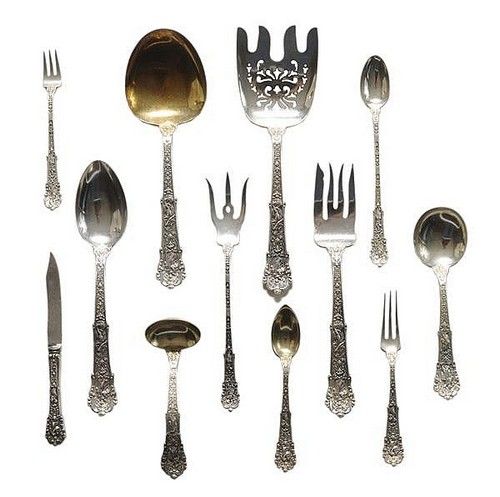

The last flatware find this week is also by Gorham in a simple sterling silver pattern called Nocturne which was introduced in 1938. The lot consists of a partial service for twelve and is lot 106 at Skinner Boston on September 11, 2013 with a pre-sale estimate of $500-700. Nocturne has a modest oval profile with a simple scrolled flourish at the bottom of the stem. It could work well in any setting from modern to traditional.
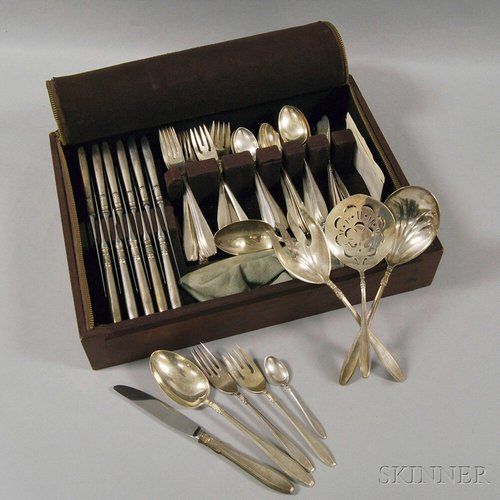
The first stemware treasure this week is a set of mid-century modern cut crystal stemware by Royal Leerdam from the 1950's. The set is being offered by Locati Auctions in Maple Glen, PA on September 16, 2013, lot 913529 with a pre-sale estimate of $500-800. This stemware has minimal cutting, thick stem and a heavy profile. It looks substantial. The Royal Leerdam set would complement the Paul Frankl dning table seen in part I as well as the After Leleu table.
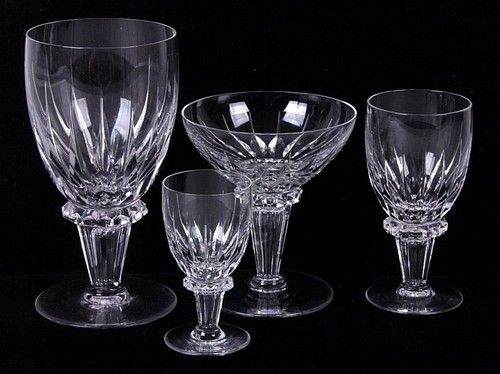
The second stemware find this week is also from Locati Auctions in Maple Glen, PA, a partial service for 6 with 18 pieces in total of crystal stemware attributed to Dorflinger and made circa 1900. The service is lot 913736 is up for auction on September 16, 2013 with a pre-sale estimate of $500-600. This glassware pattern features lovely floral and swag cutting and has a wonderful tall, elegant profile. It would certainly enhance a more traditional setting. Stemware such as this lot can be found relatively easily engraved with flowers or swags or grapes. Why not collect a mismatched set for your table? It can create a lovely look.
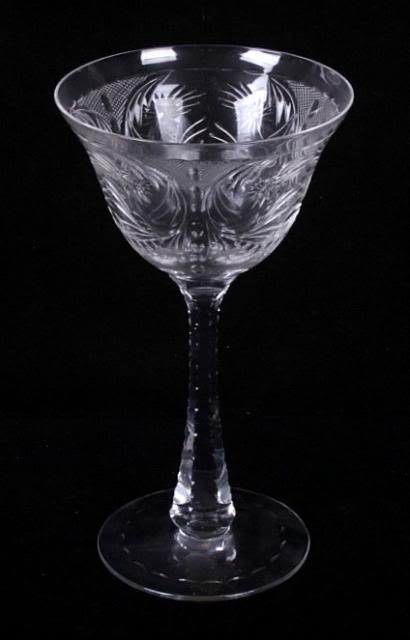
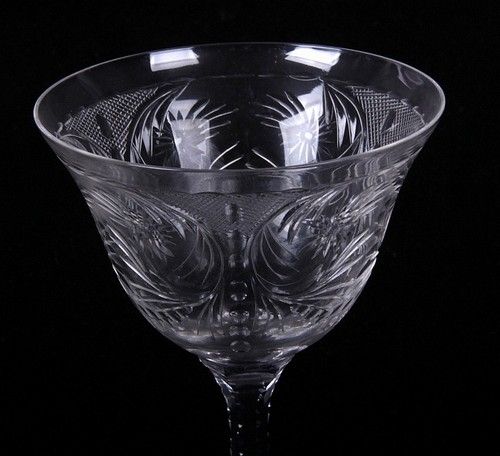
The final discovery for this week is an sophisticated and stylish set of stemware by Lalique in the pattern St. Hubert which is being offered by Rago in Lambertville, NJ on September 22, 2013, lot 2268, with a pre-sale estimate of $700-1,000. The lot consists of 56 pieces of stemware: 12 small cordials, 12 larger cordials, 11 wines, 10 sherberts and 11 goblets. The profile of the Lalique stemware is pleasing and quite chic. The stem interrupted by a simple rondel adds a nice touch. This very classic stemware would complement the modern tables found in part I and also the more traditional tables.
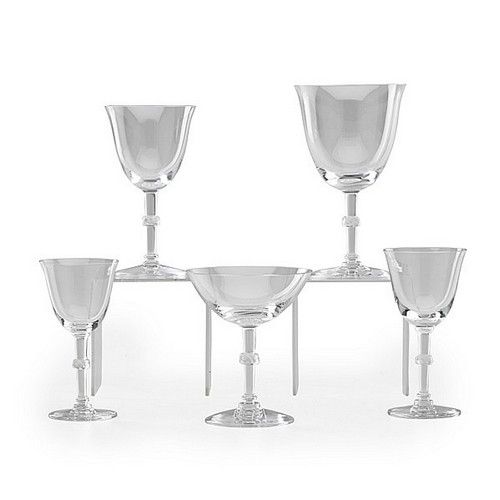
This post ends the series on elegant dining and ideas on how to appoint your dining room for daily life and entertaining. Stemware and flatware are the jewelry of the table, so choose something that enhances not only the table and but the dining space as a whole. Collect different pieces of flatware and stemware for a mismatched, fun look, but one that can also be sophisticated. Find an old pattern in plate or sterling that you like and begin to assemble a service to use. Silver flatware is not hard to care for and will add some sparkle and history to your table.
I hope this week's post provided inspiration for your own space. If you are looking for a particular antique or vintage piece for your dining room or any other space in your house, please contact me at [email protected] for help.
Until next week.
Kelly T Keating
www.theantiqueflaneur.com
AUCTION FINDS OF THE WEEK- JULY 22ND: ELEGANT DINING PART III
by Kelly Keating on 07/21/13
This week's auction finds continues our exploration of objects to create an elegant dining room and thus a lovely entertaining experience for you and your guests. In the part one of Elegant Dining the focus was on the foundation of the dining room- the table, the chairs and the plates. In part two, the finds were all items that could be used as a centerpiece which is the essential focal point of the dining room table. The centerpiece is the first and most important object in the adornment on the table.
This week's finds are 4 different types of chandeliers which could work with the tables that were selected in part one: the Louis Phillipe style table, the Georgian style late 19th/early 20th century, the Paul Frankl table and the Art Deco table after Leleu. The chandelier is not only essential for light, but its style and composition is an important component in the dining room. Sometimes a pair of chandeliers is warranted with a large table which together with the centerpiece forms a visually appealing inverted triangle. Or with one chandelier use a pair of centerpieces which then creates a pleasing triangular shape.
The first chandelier is a Vitosi Venetian glass ceiling light from the 1970's, lot 49, which is being auctioned at Christie's London on July 30, 2013 with a pre-sale estimate of $1,217-1,825. The chandelier consists of twenty five mottled clear glass spheres on a silvered frame with three light-fittings. The configuration of the glass spheres look like almost like bubbles and with the textured surface, the piece is visually dynamic.The fixture is small, 20" wide, so it would not work over a large table, but would look lovely over a small round 40" diameter table that seats 4- perfect for a chic New York apartment.

The next chandelier for this week is also made of glass, but from the early 20th century. Lot 340, a Brilliant period-style cut glass chandelier is being auctioned at New Orleans Auction Galleries on July 27. 2013 with a pre-sale estimate of $1,500-2,500. The fixture has ten lights and is supported on a vase-shaped standard hung with spear-point prisms. The two tiers of lights are decorated with swags of glass buttons and the bobeches are hung with teardrop prisms. The piece measures 34" x 29.5". The glowing lightness and visual dynamism of this chandelier would be great as a pair if possible over the Georgian style late 19th/early 20th century mahogany dining table offered in part one. This piece is of course very traditional, but it is not stuffy or oldfashioned looking. It has an intricate richness and buoyancy despite its traditional shape and components.
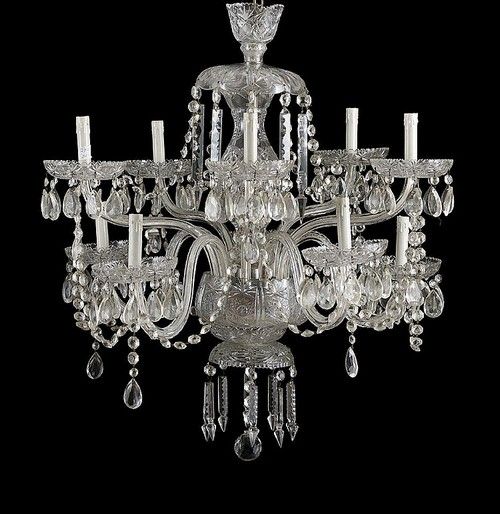
The third discovery this week is lot 228, an Art Deco bronze and alabaster chandelier being auctioned off at Carstens Galleries, Palm Beach, FL on July 25, 2013 with a pre-sale estimate of $3,800-9,000. Albaster "petals" alternate with bronze pieces with chevron decoration to form the chandelier. This fixture is visually a heavy piece. The materials used impart its richness as well as the glowing golden light passing through the alabaster shade petals. This chandelier would complement the Frankl and the after Leleu dining tables offered in part one of the Elegant Dining posts.
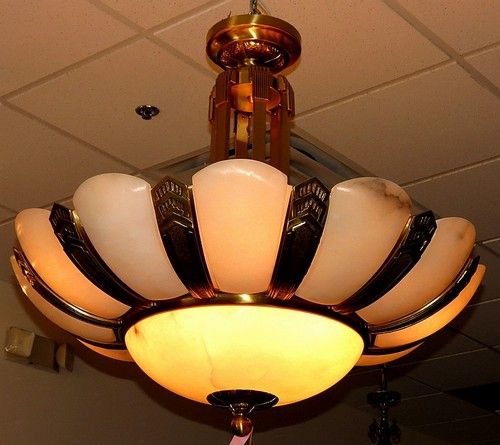
The final treasure this week is an opulent, over-the-top French ormolu and patinated bronze eight branch chandelier from the second half of the 19th century, Lot 521 is being auctioned at Christie's New York on July 23-24, 2013 with a pre-sale estimate of $3,000-5,000. The black color of the patinated bronze is a rich contrast to the gilt ormolu portions of the fixture. At the center is a figure of Cupid offering a laurel ring or wreath of greenery to the viewer. The French grandeur of this chandelier appeals to me and I would be happy to have it in my home, but clearly it is not for everyone. Many would consider it old-fashioned. It would, however, look wonderful above the oval Louis Phillipe style table shown in part one of Elegant Dining.
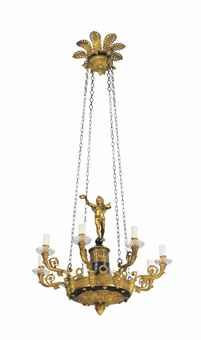
This post on Elegant Dining featured another important component of the dining room- the chandelier which is both functional and more importantly decorative. The chandelier works in tandem with the centerpiece on the table to create a focal point for the dining room and to direct the eye for the viewer. When considering a chandelier be aware of size and scale in relation to the table under it and the room size in general. Perhaps 2 chandeliers are needed with a central centerpiece or conversely perhaps one chandelier needs 2 centerpieces on the table.
I hope this week's post provided inspiration for your own dining space. Next week's post will focus on the final essential feature of elegant dining, namely flatware and stemware.
For the auction results of this post's lots and those in earlier posts, please take a look at my Facebook Page.
If you need help finding a chandelier for your home, please contact me at [email protected].
Until next week,
Kelly T Keating
www.theantiqueflaneur.com
AUCTION FINDS OF THE WEEK- JULY 15TH: ELEGANT DINING PART II
by Kelly Keating on 07/15/13
In last week's post "Elegant Dining Part I" I found items to create the foundation of well-appointed dining room for entertaining- the table, the dining chairs and the plates to be used at a soiree. This week the blog will focus on how to begin to fashion a tablescape with a beautiful centerpiece which will become the focal point for your table for when it is in use and when it is not. This week's treasures, I hope, will provide inspiration for your own dining room and the elegant dining that can take place within it.
This week's first discovery is a pair of French gilt-bronze 3 light candelabra from the 20th century, lot 464, to be auctioned off at Christie's New York on July 23-24, 2013 with a pre-sale estimate of $1,000-1,500. With its swirling, undulating design with foliage and flowers, this pair may be Art Nouveau in date or perhaps later as their style also suggests the Rococo. Having a wonderful pair of candelabra or candlesticks is almost essential for any table and creates a wonderful ambiance for dining when lit. This large pair would work well on the Georgian style 19th century mahogany dining table from last week's finds and even would work on the 2 modern tables- the Paul Frankl and the after Leleu. And of course a large complementary centerbowl perhaps Chinese or glass to sit between the candelabra would be a great touch. Fill it with fruit, small pots of ivy, or small flowering plants.
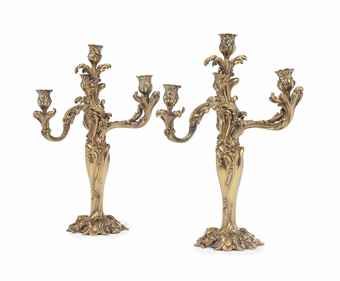
Instead of a single centerbowl to accompany the candelabra, how about a group of 4 800 silver continental trumpet vases from Switzerland, lot 89, to be auctioned off also at Christie's New York on July 23-24, 2013 with a pre-sale estimate of $1,500-2,000. The vases date to the early 20th century, have a hammered trumpet form with a reticulated band of flora and fauna at the base and a gilt interior. The 4 9" tall vases would complement quite well the French candalabra above in their similar motifs and the mixing of gold and silver metal. The combination would work well on the more traditional dining room tables from last week as well the more modern ones.
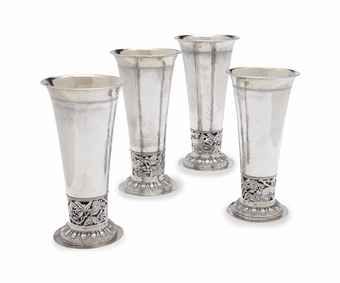
Just as much as they can certainly complement a more traditional space, Chinese decorative objects can work well in a modern setting as well. The next 3 treasures this week are Chinese in origin. Lot 12, a pair of late 18th/early 19th century blanc de chine Dehua vases is being auctioned online at Christies, New York with an end date of July 23, 2013 with a pre-sale estimate of $2,000-3,000. The cylindrical vases are a beautiful creamy white color and are decorated with applied prunus branches. An emblem of winter and one of the "Three Friends of Winter" because of the tenacity of its blooms through the long, cold months, the plum, or prunus branch was a favored decorative motif of the Dehua potters. Sometimes molded and sometimes applied, the small, snow flake-like flowers appear on a variety of vessel shapes, adding depth and texture to the flat, glossy surfaces.
The vases are a good size at approximately 9.5". Their neutral color and sparse elegant decoration would look wonderful on the dark wood of any of the tables from last week's post. I would group them with other blanc de chine items of different sizes making 2 groupings of 3 and a most pleasing tablescape.
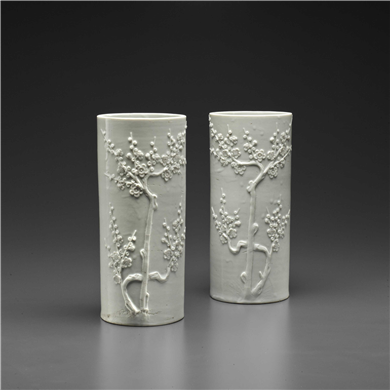
The next Chinese find for a potential tablescape is lot 146 a pair of green Peking glass bottle-shape vases to be auctioned at Skinner in Boston on July 26, 2013 with a pre-sale estimate of $600-800. The color of these vases is gorgeous and like the blanc de chine vases from Christie's I would use these Peking glass vases as the starting point for 2 groupings of 3 on a dining table. At 10.5" tall this pair is a good start and will bring color to the center of the room. Why not fill them with blossom branches for added height and contrasting color in the room.
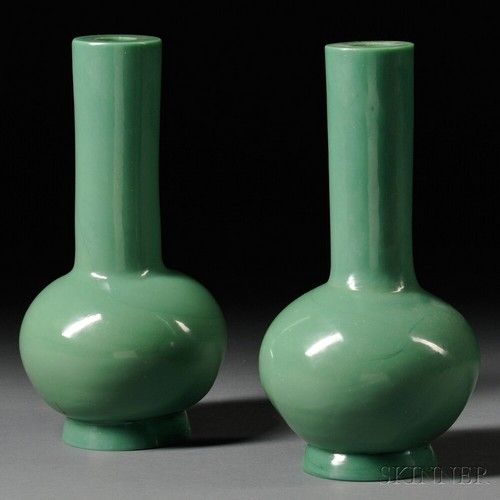
Also at Skinner in Boston is lot 82 a pair of export Nanking style blue and white Meiping vases with a pre-sale estimate of $400-600. The vases are 20th century in date and painted with floral sprigs and reserves depicting riverside pagodas and houses with gilt decoration. They stand at almost 10" in height and like the other 2 Chinese lots they are a good starting point for a pair of groupings of 3 blue and white vases for the dining room table. Blue and white porcelain is ubiquitous and can be found at many price points and from many periods.
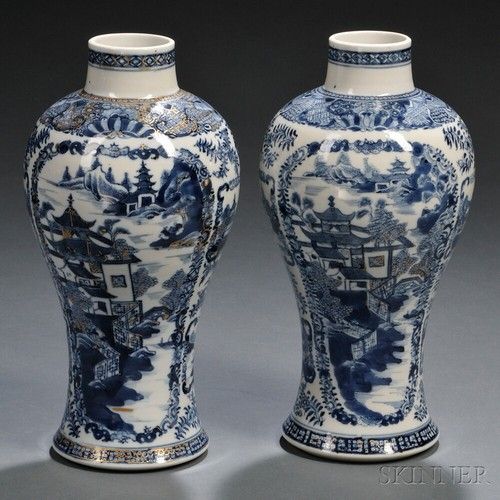
The next discovery this week for the center of the dining room table is a French crystal free-form undulating bowl hallmarked Cofrac Art Verrier France, lot 6, being auctioned off at the Palm Beach Auction Gallery in Florida with a pre-sale estimate of $300-400. The bowl is an impressive size 14" tall x 24" wide. This piece would look wonderful on the modern dining tables in last week's finds. It would even look good when paired with the French gilt-bronze candelabra that started off this week's finds.
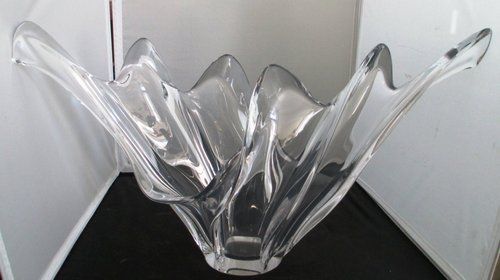
This week's next find is also crystal. Lot 120 is a 19th century Anglo-Irish cut crystal 3 piece garniture consisting of 2 12" tall candlesticks and an 11.75" tall covered vase or compote is being auctioned off online by Millea Bros. in Madison, NJ ending on July 20, 2013 with a pre-sale estimate of $70-100. This garniture would work well on the more traditional dining tables from last week perhaps interspersed with open vases that could be filled with flowers.
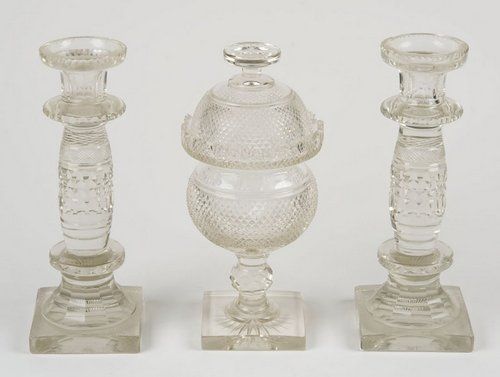
This week's next treaure is a centerpiece bowl in a vibrant green Bohemian crystal, lot 15, to be auctioned off at Van Michael's Consignment LLC in West Palm Beach, Florida with a pre-sale estimate of $200-300 on July 20, 2013. The piece has circle and star design and is a great size at almost 14" in diameter. The green color of the bowl would look great in a room with that color. When placed on the dining room table, it would draw all that color into the center of the room.
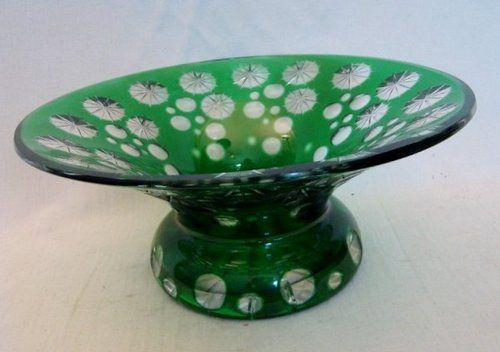
The next find is another piece of Bohemian glass- a pair of green and gilt glass pokals or tall drinking cups, lot 427, being auctioned off at Doyle New York on July 18, 2013 with a pre-sale estimate of $200-400. A good size at 9.5" tall, this pair would work well with a large centerbowl or grouping of candlesticks on either the modern or traditional tables shown in last week's blog entry.
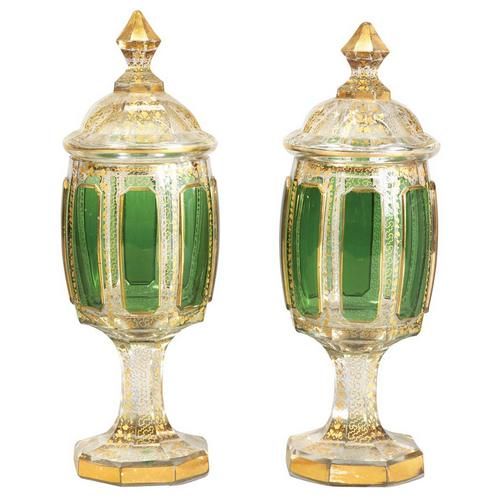
The last discovery for this week is fun lot also being auctioned at Doyle New York on July 20, 2013. Lot 332 is a lot of 4 polished metal flower form vases probably with not much age with a pre-sale estimate of $500-700. The vases are of staggered heights, the tallest of which is nice 18". The set would be great on both the after Leleu and the Paul Frankl table which I posted last week. Either use 3 of the vases in the center of the table or pairs at either end accompanied by a glass or silver candlestick.
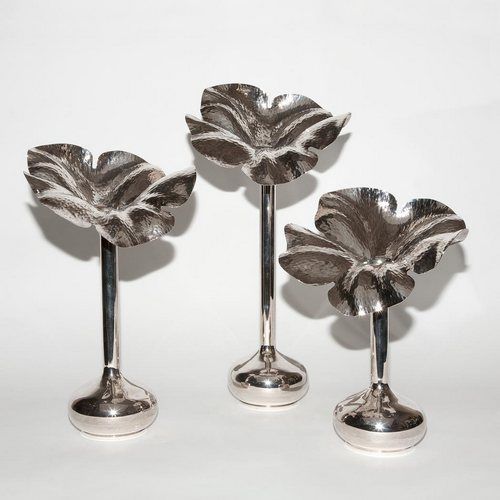
This week's auction finds focused on the adornment of the dining room table in order to create a visually appealing tablescape and an elegant dining experience. Try using different types of pieces on the dining room table. Group vases, compotes and candlesticks of different heights, but with similar coloring, style or motifs. I hope this week gave you some inspiration for your dining room and its tablescape. Next week's finds will focus on the chandelier, another important aspect to consider in creating a dining room. And if you missed last week's post take a look at it here for the starting point of any dining room: the table, the chairs and the plates.
Also check out my Facebook Page where I list the results for all the auction finds for each week.
If you need help adorning your dining room, please email me at [email protected]
Till next week,
Kelly T Keating
www.theantiqueflaneur.com
AUCTION FINDS OF THE WEEK- JULY 8TH: ELEGANT DINING PART I
by Kelly Keating on 07/07/13
This week's auction finds is the first in a series of posts that discovers items needed to create an elegant dining tablescape and experience. This first post will concentrate on the bones of the dining room- a table and chairs as well as plates. Plates for the table is the first essential piece in creating your tablescape.
The first treasure this week is a Paul Frankl mahogany and brass dining externsion table, lot 57, at Stair Galleries in Hudson, NY on July 13, 2013 with a pre-sale estimate of $2,000-3,000. The table has a divided cork top and is fitted with two additional leaves. Without the leaves the table is 6' in length. Paul Frankl (1886-1958) was an Art Deco furniture designer and maker, architect, painter and writer from Vienna, Austria. The detail of the legs with their crossed supports with the brass fittings is quite stylish on this table.
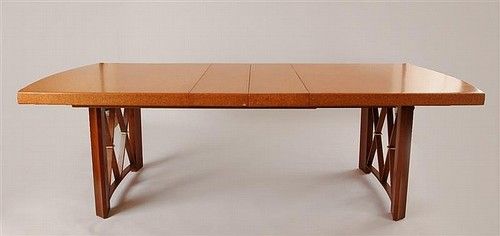
The next table find is also at the Stair Galleries in Hudson, NY and is being auctioned on July 13, 2013. It is a Mid-century walnut dining table, after Leleu, lot 51, with a pre-sale estimate of $1,200-1,800. (Auction note: When a lot states after ____ or other similar terms such as manner of, style of, bears the signature, school of, the object in the lot bears similarities to a particular author or maker, but it is not by that author). The walnut dining table has wonderfully bent pieces of wood that fashion the apron and the legs which terminate in a cross. The top seems to be tension set in the 4 pieces making up the legs and the apron.
Jules Leleu (1883-1961) was a French furniture designer. Leleu studied decorative painting and at the age of 26 succeeded his father in the family painting business. With his brother he began work in the Decorating field. After World War I, Leleu specialized in furniture making. He opened a Paris gallery, Maison Leleu, in 1924 and exhibited at the 1925 Exposition Industrielle et Arts Decoratifs, winning a grand prize at the exposition. Leleu designed the Grand Salon of the Ambassadors at the Society of Nations in Geneva and the French Embassies of several nations as well as the ocean liners SS Ile de France and SS Normandie.
The next table find for this week is more traditional in nature. Lot 115 is a late 19th/early 20th century mahogany dining table in the Georgian style to be auctioned off on July 12, 2013 at Skinner in Boston with a pre-sale estimate of $1,000-1,500. The dining table was made in England. It has two D-shaped ends and three leaves, string-inlaid frieze, all standing on reeded Marlborough legs with casters. This table is quite grand and with the leaves measures almost 10 feet in length. It is meant for the most spectacular of rooms, but since it is a copy of an earlier Georgian form it has a very good price point.
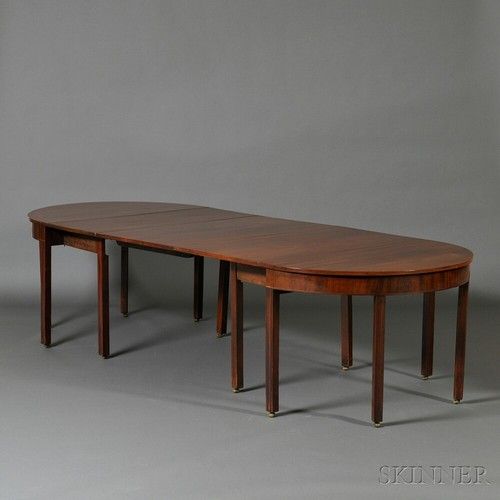
The final table found this week is a Louis Phillipe style oval mahogany dining table, lot 849, to be auctioned off on July 15, 2013 at Leslie Hindman Auctioneers in Chicago with a pre-sale estimate of $2,000-4,000. The piece probably dates to the late 19th or early 20th century. The table has inlaid banding on the top, above a conforming plain frieze and raised on tapering legs that end in brass caps and casters. At only 5' long, this lot is a good size for a small space.
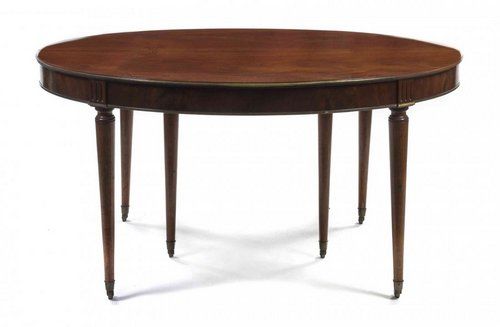
Now that there are some tables to choose from, chairs are needed next. The first group of chairs is a set of 8 Art Deco mahogany chairs after Leleu. Lot 50 is up for auction at Stair Galleries in Hudson, NY on July 13, 2013 with a pre-sale estimate of $1,500-3,000. The chairs have a shaped, curved solid wood back above simple tapering legs. They are upholstered in black suede. I would certainly change the fabric on these pieces to something lighter and more neutral. These chairs would work well with the after Leleu dining table shown above.
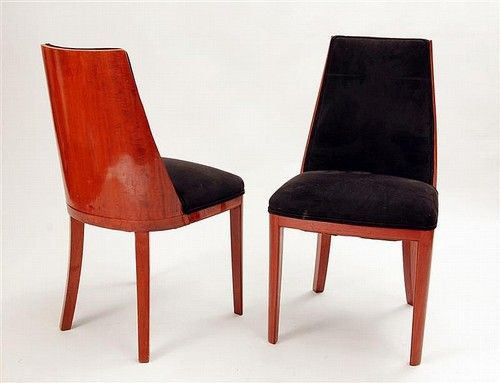
For the Frankl table I found an assembled set of 14 Josef Hoffman for Thonet ebonized dining chairs consisting of 2 arm chairs and 12 side chairs. Lot 142 is being auctioned at Stair Galleries in Hudson, NY on July 13, 2013 with a pre-sale estimate of $2,000-4,000. The existing fabric on the chairs is awful and would look much better with a soft, textured neutral. Josef Hoffman (1870-1956) was an Austrian architect and designer of consumer goods and Michael Thonet (1796-1871) was a German-Austrian cabinet maker.
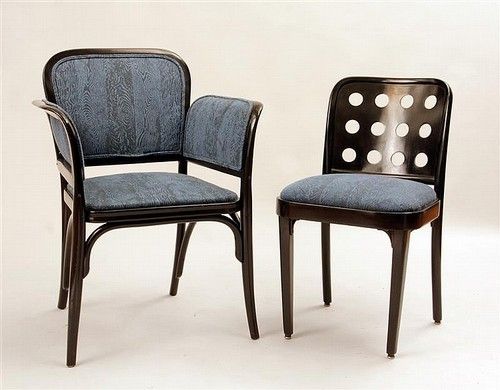
For the 2 more traditional tables, lot 192 is a good match, a set of 8 Regency (1811-1820) mahogany dining chairs being auctioned at Leslie Hindman in Chicago with a pre-sale estimate of $1,000-2,000. The set is comprised of two armchairs and six side chairs. Each chair has a straight crest rail above a pierced horizontal splat, over the trapezoidal upholstered seat. The chairs are raised on ring turned legs with cylindrical feet.
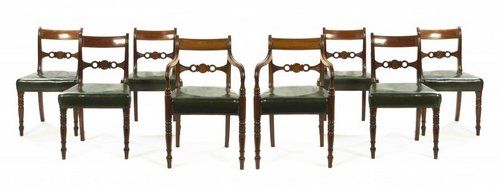
The second traditional chair lot is also being auctioned at Leslie Hindman in Chicago. Lot 195 is a set of 6 William IV (1830-1837) mahogany dining chairs with a pre-sale estimate of $600-800. The set is comprised of one armchair and 5 sidechairs, each having a straight crest rail over a pierced horizontal splat and upholstered seat. The whole chair raised on turned tapering legs ending in cylindrical feet. These chairs are a bargain in part because there is only one armchair, but they would work well in an apartment with a dining area or a small dining room in a house.
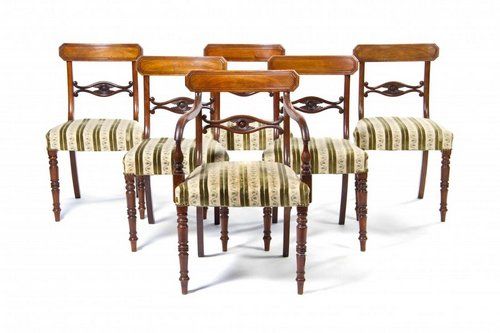
After the table and chairs, an elegant dining experience needs the perfect plates with which to adorn the table. The first plate find is lot 1111 a late 19th century set of 10 Doulton Burslem blue transfer decorated plates being auctioned at Alex Cooper Auctioneers in Towson, MD with a pre-sale estimate of $200-300. These plates are wonderfully colorful and dynamic in their design of stylized flowers and foliage. Such plates could work on the modern tables as well as the more traditional pieces.
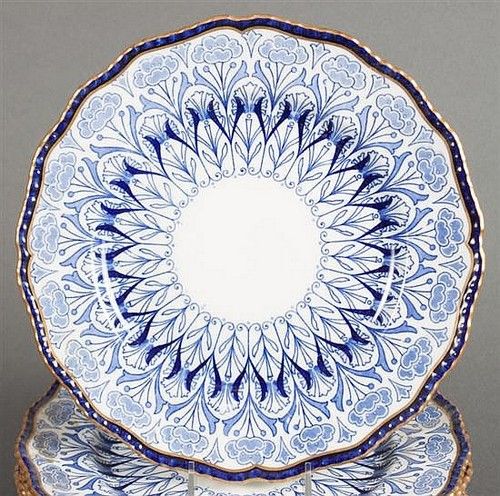
The next dinnerware find is lot 1450 an early 20th century set of 12 Wedgwood green majolica leaf and vine plates being auctioned at Freeman's in Philadelphia on July 17, 2013 with a pre-sale estimate of $200-400. I think too these green plates would work well on both a traditional as well as a modern table depending on the colors of the room and the fabrics used. These plates are slightly smaller than dinner plates and would be wonderful to use for brunch or a luncheon.
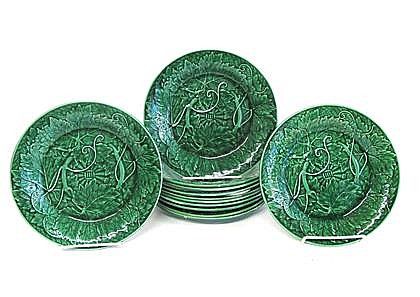
Also being auctioned off at Freeman's in Philly on July 17, 2013 is lot 1433, an early 19th century set of 12 Derby Imari pattern porcelain dinner plates with a pre-sale estimate of $300-400. The Imari pattern of blues and oranges with gilding was copied by European manufacturers from Japanese wares made in the town of Arita. I would use these plates on both the traditional and modern tables especially with their grahic floral and foliage motif. I think the orange enameling in the plates would complement the wood tone of the after Leleu and Frankl table.
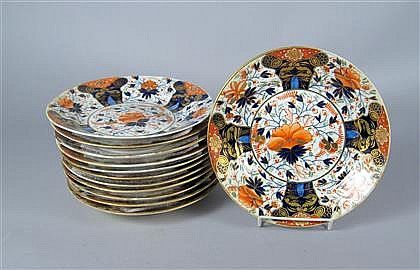
Lot 1305 is a simpler dinnerware and does not have an intricate pattern. The lot consists of 20 early 20th century Minton porcelain plates with a gilt rim and a pale pink band and is being auctioned at Alex Cooper Auctioneers in Towson, MD on July 14, 2013 with a pre-sale estimate of $400-600. The simplicity of these plates would work well with the modern tables and chairs. One can find other patterns by Minton with the same gold rim and different colored bands. If pink does not coordinate with the colors of your dining room, try to find one that does or even just a plate with a gold rim is quite elegant and would work on a modern table as well as a traditional one.
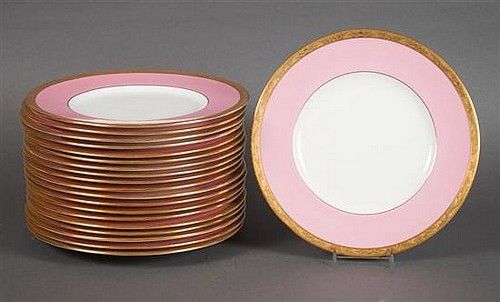
The final plate lot is my most favorite and I would be happy to have it in my own house. Lot 1508 is a 19th century set of 10 French hand-painted and gilt porcelain dessert plates by Rihouet Lerosey, Paris. These plates are being auctioned off at Freeman's in Philly on July 18, 2013 with a pre-sale estimate of $600-800. The French plates are in a shaped circular form with a striking blue border. In the center of the plates is a superb monogram "H" surmounted by a crown. What a fantastic lot of French porcelain that would look great on a traditional table and certainly would wow your guests for dessert.
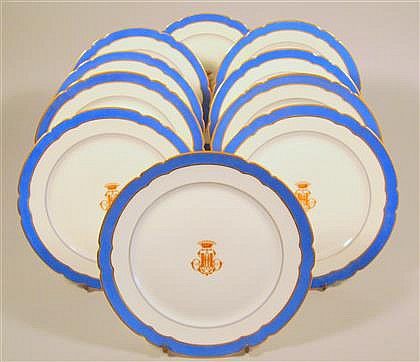
This first post in the "Elegant Dining" series focused on tables, chairs and one of the essential pieces of your tablescape- the plate. I hope the selected lots inspired you in the creation of your dining space and the entertaining you do in it. Next week "Auction Find" will focus on other items needed for your sophisticated dining tablescape such as glassware, flatware and the centerpiece.
If you need help finding items for your table, contact me at [email protected]
Until next week,
Kelly T Keating
www.theantiqueflaneur.com
AUCTION FINDS OF THE WEEK- JULY 1ST: MIRROR, MIRROR ON THE WALL...
by Kelly Keating on 07/01/13
Mirror, mirror on the wall... This week's auction finds are all mirrors from various periods and in differing styles. A well-placed mirror can brighten a room and give it a sense of greater space. Even more importantly, it can be the focal point of an entire room around which the whole design coalesces. A looking glass through its design sets the tone for the room and can be the starting point for a large wall grouping. All the items this week are being auctioned off at Christie's at their Interiors sale on July 23-24, 2013.
This week's first discovery is a bit over the top, but it suits me just fine. Lot 340 is a North Italian giltwood mirror from Tuscany circa late 18th centuy. It is being offered with a pre-sale estimate of $3,000-5,000. There is a luxury and richness to a giltwood mirror whether it is sleek or very elaborate as lot 340 that works in most spaces. Introducing a metallic into a room is always well-received. This large mirror (79"x36") is Neo-classical in style and features a crest of a central phoenix holding a shield flanked by 2 other phoenix. Dripping elegantly down the side from the crest are lovely bellflowers. The glass of the mirror has lost its silvering here and there which contributes to its air of faded elegance. I see this mirror working in both a simple setting with neutral, rich fabrics becoming the focal point of the room or in a very elaborate setting where it is part of a whole intricate ensemble.
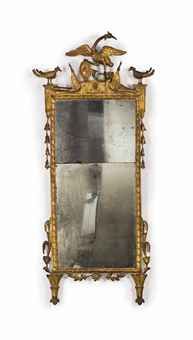
The next mirror discovery is also Neo-classical in style and giltwood in form, but early 20th century in date. Lot 252 is an English Edwardian giltwood mirror with a pre-sale estimate of $1,000-1,500. The acanthus leaf detailing of the crest and the swagging bell flowers attest to its Neo-classical style. The mirror is a wonderful oval and a large size at 52"x29".

The third discovery this week is quite a departure from the first two. Lot 449 is an Art Deco wrought iron mirror from the second quarter of the 20th century. It is being offered with a pre-sale estimate of $1,000-1,500. With a lengthwise oriented oval this mirror has simple scrolling at the ends and is hung with a tasseled cord. The surface of the mirror frame is enhanced by a ridging texture that enlivens its surface and suggest the industrial and mechanical nature of Art Deco. It is not a very large mirror, but could be a nice complement over a Deco sideboard or a Mid-century Modern piece.
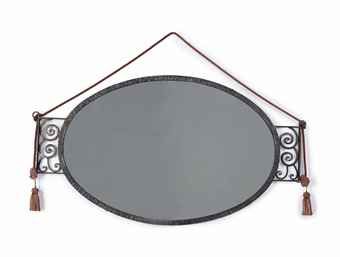
The next 2 finds are English mirrors from the George II period who reigned as King from 1727-1760. Lot 387 is a walnut and parcel-gilt mirror from the mid-18th century. In its scrolling outline, rich wood grain, broken pediment, swirling acanthus leaves and rich gilding, it is evocative of the Rococo period. It has a pre-sale estimate of $3,000-5,000. Quite a grand piece which would need to occupy the right seating in order to really work in the space.

The second George II mirror is much simpler in design. Lot 347 is an English mahogany parcel-gilt mirror from the late 18th/early 19th century. This mirror demonstrates a move away from the curving forms of the Rococo to a simpler Neo-classical style with its rectalinear shapes and severe pediment. I adore the small gilt balls on the bottom of the mirror. It has a pre-sale estimate of $4,000-6,000.
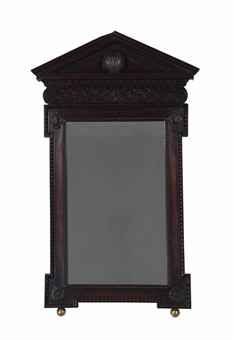
The last discovery this week is a mirror that does not hang on the wall. Rather it is freestanding and would be great in a bedroom or even more fabulous in a neutral all-white bathroom. Lot 537 is a Regency mahogany cheval mirror circa 1820 with a pre-sale estimate of $1,500-2,000. It has lovely reeded legs with brass paw feet and is on wheels. What a great piece!
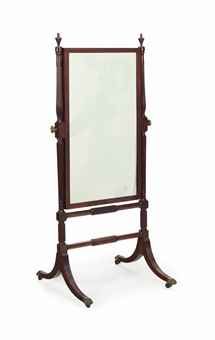
A mirror can be the dramatic focal point of a room as well as making the space feel brighter and bigger. All of this week's finds would be an expressive addition any room. Perhaps the first more elaborate and fancy George II mirror might be a tough sell, but it certainly wouldn't be missed. I hope this week's finds provided some inspiration for the creation of your own space.
If you need help finding a mirror or another antique or vintage object, please contact me at [email protected].
Till next week,
Kelly T Keating
www.theantiqueflaneur.com
